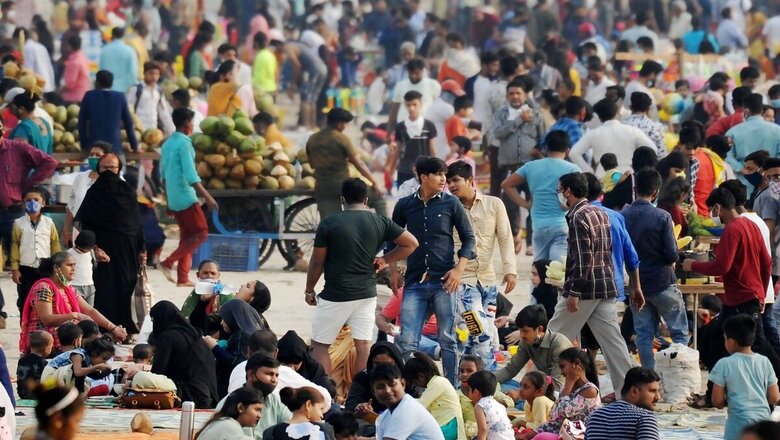
views
A recent report of an expert committee in India, analysing reasons for the Covid-19 resurgence in Maharashtra, attributed a “lack of fear of disease” as one of the factors for the deadly infection spreading rapidly again after a lull. Crowds jostling in streets and overcrowded local trains bear witness to this fact. Covid-19 is the deadliest pandemic the current generation has ever seen. The number of infections and death toll is unnerving. It is an immense systemic shock to the lives and livelihoods, and is unprecedented in scale and uncertain in repercussions. Still, we do not fear it enough to take simple measures such as regular mask-wearing and are casual about our own safety. Such behavior is counter-intuitive to evolutionary principles of survival. Or is it? Let’s examine.
If Covid-19 were a mountain to climb, the Spanish flu of 1918 would have hewn the arduous path we currently tread. A century of progress has gone by, yet we fumble to find a smoother, faster, and surer route to the summit. Much ground lies covered in our understanding of pandemics. We regularised fugitive words such as quarantine, social distancing, and mask-use into the public health lexicon precisely 102 years back. Still, the current epidemic exposes how we, as a society, are not very good at assessing the risks we face and how to prepare for it. Communication and response suffer as a consequence, leading to a much higher toll in life and limb. This is avoidably deadlier than the scenario where systemic memory of earlier events prevails, expert opinion is considered, and available data and trends are used to make more realistic and effective decisions.
Public health experts have often warned us of a respiratory pandemic that can wreak global havoc. In 2015, we saw an unassuming Bill Gates walking in to give a Ted talk, hauling a tank of emergency food supplies issued by the Department of Defense. A warning on an imminent nuclear war had garnered the community’s fervid attention in his childhood, and his parents had dutifully stocked such tanks in their house. He instead claimed that it would be a microbe, and not a nuclear incident, that would probably kill tens of millions of people over the next few decades. He was eerily prescient in using a cartoon of a spiky, round virus to represent that microbe. We did not heed. Five years later, the world is in the pernicious grip of this single helix (a spiral strand of genetic material) — a spiny virus looking exactly like the cartoon Gates used in his presentation.
What makes us build stockpiles for rare risks like a nuclear disaster and readily establish anti-terrorism squads but ignore commonly observed events where there is a much higher chance of death or disability like motor vehicle accidents or an epidemic? Brain science says this results from the subjective perception of different risks — their relative ranking and expected outcomes — in individuals’ minds. Such evaluation is far removed from an expert’s ranking based on assessing resultant mortality and other evidence on harmful consequences. In general, threats that are perceived more out of our control, i.e., involuntary, like a nuclear disaster or a chemical calamity like the Bhopal Gas tragedy, are feared more than those more familiar, like train accidents. The latter type of disasters is more commonplace and thus evokes less dread. The relative certainty in our minds that these are distant, predictable, and manageable makes us under-weigh their prospects in our lives. Respiratory illnesses and infectious diseases fall into the more voluntary and controllable group of risks. People tend to get careless with these, too, as we are witnessing during the current pandemic.
Where and why does this potentially fatal bias originate? Experts say our “lizard brains” are to blame for this aberration in our perception of harmful risks. These primitive structures in our brain, like Amygdala, Hypothalamus and Basal Ganglia (which we do share with lizards), make us evaluate threatening events terrifically fast for assessing their immediate impact on our lives. Here, our brain uses quick rules of thumb (heuristics) formed by previous experience, adaptive intuition, imagery, and associated emotions. This unique sense-making compels us to either fight or take flight from the perceived danger, literally at the speed of thought. Fright guides both these reactions, and such automatic knee-jerk actions are essential to our survival in the face of sudden danger.
An extended disaster like the Covid pandemic brings rational thoughts to the forefront of our threat perception as flight and fight responses recede in utility with time. Logically, that means we must start to consider available data on disease spread and mortality and become more careful about prevention. Instead, we overshoot the line of rationality in the opposite direction. By a lot! We now fall prey to another bias. We are guided to treacherous ease and a feeling of safety by our subconscious, even when the danger continues to prevail. We tend to become cavalier and careless as the familiarity with the disease increases. Culture also influences such behavior. In India, our long-standing exposure to infectious diseases and a somewhat fatalistic attitude to death, illness and disaster may be the factors leading to the lack of sufficient fear of the consequence of Covid-19. It may also be the case that the population driving the spread of the disease in India is young and relatively less at risk of severe disease. The old and people with co-morbidities lack the agency to derive the societal sentiment towards more caution.
Fortunately, this gap in perception, attitudes, and behavior can be quickly filled by government communication and oversight that guide the general population towards safety and protection. We achieved similar results through effective communication on HIV/AIDS. Disincentives such as fines for not adhering to safety measures also reinforce positive attitudes and actions.
Studies show that public perception is significantly influenced by political messaging about the risk: civic values like power, trust, and conflicts usually retard truthful communication during a crisis. Wartime propaganda tampered with public health messaging in 1918; public authorities dreaded the spread of fear more than the spread of the deadly pandemic. “Worry kills more people than the disease itself,” a Chicago public health official was quoted as saying. Other quotes were: “Don’t get scared”, and “The so-called Spanish influenza is nothing more or less than old fashioned grippe”. Fortunately, public messaging on Covid-19 in India, unlike that in the USA, was truthful, scientific, and consistent. And that helped immensely to keep numbers and fatalities related to Covid-19 much lower than what was initially feared.
Our confrontation with Covid-19 is not the last tango in the helix between humans and a pandemically inclined pathogen. Humanity has repeatedly faced catastrophic events of pervasive nature. We minimised the risk of one through our ingenuity, innovation and bipartisanism, only to meet another of magnified capriciousness. Given our frequent encounters with such events, we expect that we remember to be careful about assessing similar risks and stay leery while being in constant business of optimising our chances of survival. Regrettably, our minds do not automatically prepare us for a doomsday risk, which is what Covid-19 has proved.
Disclaimer: The author is a doctor and Indian Administrative Services officer who has worked as Special Secretary, Health; Commissioner Food Safety; Drugs Controller, and Project Director for HIV/AIDS Control Program for Delhi Government, India. She is currently pursuing doctoral studies in public health at Harvard University. She is an MA in Economics from the University of Texas at Austin. She is also certified in Data Analytics and Machine Learning from McComb’s School of Business, USA. Views expressed are personal.
Read all the Latest News, Breaking News and Coronavirus News here




















Comments
0 comment